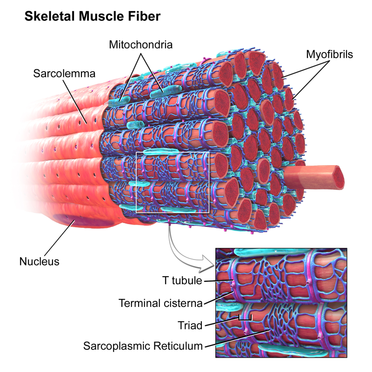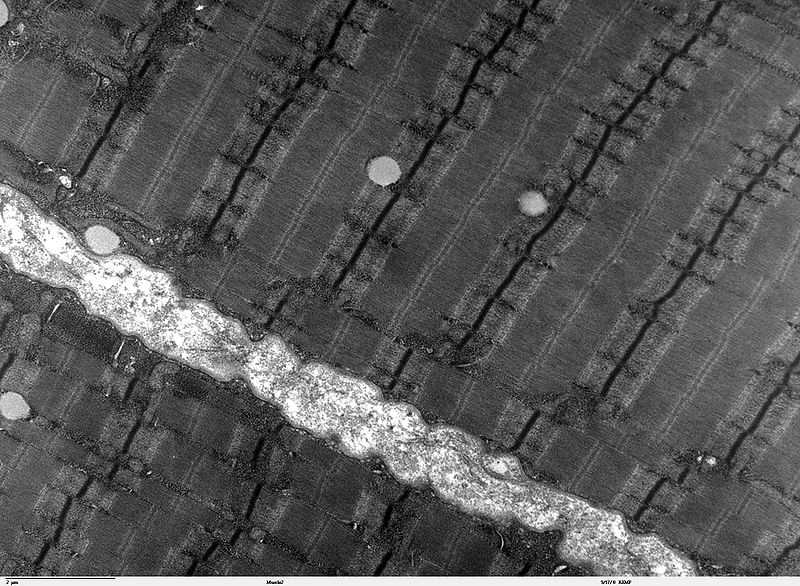Bone Anatomy
|
In short, BONE IS COMPOSED OF:
|
Bone is composed of both organic (20-40% by weight) and inorganic (50-70% by weight) elements, as well as water (5-10% by weight) and lipids (<3% by weight). What makes the organic element "organic" is living proteins. And what makes the inorganic element "inorganic" is minerals. The organic portion of bone is mainly type 1 collagen, but also includes bone cells (osteoblasts, osteoclasts and osteocytes) and non-collagenous protein (proteins that are not collagen). The organic portion of the bone matrix is also referred to as osteoid. The minerals that make up the inorganic portion of bone are mainly calcium and phosphate, a collective component known as hydroxyapatite. Other minerals that also make up the inorganic portion of bone are carbonate, magnesium and acid phosphate (Clarke, 2008).
Muscle Anatomy
|
Skeletal muscle, or "voluntary" muscle, is connected to the skeleton that forms a mechanical system to propel the body through space and is composed of many muscle fibers that are organized into several collagenous layers: epimysium, perimysium and endomysium. The rabbit hole begins with the epimysium; the epimysium is the outer-most connective tissue layer that covers the entire muscle belly. Digging deeper, the perimysium is the connective tissue that covers muscle bundles. The endomysium is the inner-most layer covering muscle fibers. Running parallel within each muscle fiber exists about 2500 myofibrils. Inside the myofibrils, the sarcolemma is found.
|
The sarcolemma is the muscle cell membrane. Each muscle cell contains basic and muscle-specific organelles including about 30 nuclei (the control center) per millimeter, mitochondria (the powerhouse) and sarcoplasmic reticulum (network of channels that store calcium and surround each myofibril). Each myofibril is composed of about 8000 sarcomeres. The sarcomere is considered the basic contractile unit of the muscle cell. The sarcomere is able to contract with help of the myofilaments (myo = muscle, filament = threadlike fiber). The myofilaments are composed of contractile proteins, primarily actin and myosin, but also includes tropomyosin and troponin. Myosin is considered the thick filament, actin is considered the thin filament. Troponin and tropomyosin exist on actin, the thin filament. Structural proteins also exist to hold the contractile proteins in place (Chawla, 2016), (Savell, 2016).
Muscle Fibers
Muscle fiber types can be broken down into the following categories:
Next, let's define the possible muscle fiber adaptations:
Finally, let's cover the types of muscular contractions:
Increases in muscle strength are the result of an increase in muscle size and neural adaptations (Birch, MacLaren, & George, 2004), (Hoffman, 2009), (Moritani & de Vries, 1979), (Sale, 1988). Muscular strength can be assessed using a fraction of an individuals one repetition maximum (1 RM), which is the greatest resistance that can be moved through an individuals full range of motion, controlled with good posture (Pescatello, Arena, Riebe, & Thompson, 2013). Research suggests that heavy resistance exercise, or a high percentage of an individuals I RM, results in optimal muscle hypertrophy. However, this phenomenon does not occur without the presence of eccentric muscle contractions. In addition, fast-twitch muscle fibers have a higher potential to increase muscle size compared to slow-twitch muscle fibers (Hather, Tesch, Buchanan, & Dudley, 1991). Research suggests a high-quality, post-workout protein supplement, such as whey, results in an increase in muscle strength (Willoughby, Stout, & Wilborn, 2006).
- Type I: also known as slow-twitch or slow oxidative; aerobic (use of oxygen) capacity with contractile properties that are characterized by slow speed, low force production and high resistance to fatigue
- Type IIa: also known as fast-twitch or fast oxidative-glycolytic; aerobic and anaerobic (use without oxygen) capacity with contractile properties that are characterized by fast speed, moderate force production and low resistance to fatigue
- Type IIx: also known as fast glycolytic; anaerobic capacity with contractile properties that are characterized by fast speed, high force production and low resistance to fatigue (Baechle & Earle, 2008), (Hoffman, 2009).
Next, let's define the possible muscle fiber adaptations:
- Endurance: repeated force production over a long duration; resistance training regimen to build muscular endurance is characterized by low intensity and high volume
- Hypertrophy: increase in muscle fiber size; resistance training regimen to build muscular hypertrophy is characterized by moderate intensity and moderate volume
- Strength: maximum force production exerted by a muscle group; resistance training regimen to build muscular strength is characterized by high intensity and low/moderate volume
- Power: force production over an elapsed time; resistance training regimen to build muscular power is characterized by high intensity and high intensity and low volume (Birch, MacLaren, & George, 2004), (Hoffman, 2009).
Finally, let's cover the types of muscular contractions:
- Concentric contraction: force production that results as the muscle fiber shortens
- Isometric contraction: force production that does not result in a change in muscle length
- Eccentric contraction: force production that results as the muscle fiber lengthens
Increases in muscle strength are the result of an increase in muscle size and neural adaptations (Birch, MacLaren, & George, 2004), (Hoffman, 2009), (Moritani & de Vries, 1979), (Sale, 1988). Muscular strength can be assessed using a fraction of an individuals one repetition maximum (1 RM), which is the greatest resistance that can be moved through an individuals full range of motion, controlled with good posture (Pescatello, Arena, Riebe, & Thompson, 2013). Research suggests that heavy resistance exercise, or a high percentage of an individuals I RM, results in optimal muscle hypertrophy. However, this phenomenon does not occur without the presence of eccentric muscle contractions. In addition, fast-twitch muscle fibers have a higher potential to increase muscle size compared to slow-twitch muscle fibers (Hather, Tesch, Buchanan, & Dudley, 1991). Research suggests a high-quality, post-workout protein supplement, such as whey, results in an increase in muscle strength (Willoughby, Stout, & Wilborn, 2006).
Being aware of the muscles, their action, origin and insertion, can help bring clarity to the mechanisms of movement. Without movement, the human body collapses. For a more in-depth exploration of the musculoskeletal system, click the link below.
References
Chawla, J. (2016, October 28). Muscular system anatomy: Overview, gross anatomy, microscopic anatomy. Retrieved December 4, 2016, from Medscape, http://emedicine.medscape.com/article/1948554-overview
Clarke, B. (2008). Normal bone anatomy and physiology. Clinical Journal of the American Society of Nephrology, 3(Supplement 3), 131–139. doi:10.2215/CJN.04151206
Savell, J. W. (2016, January ). Structure and composition of muscle - meat science. Retrieved December 4, 2016, from Texas A&M University, http://meat.tamu.edu/ansc-307-honors/structure-muscle/
Clarke, B. (2008). Normal bone anatomy and physiology. Clinical Journal of the American Society of Nephrology, 3(Supplement 3), 131–139. doi:10.2215/CJN.04151206
Savell, J. W. (2016, January ). Structure and composition of muscle - meat science. Retrieved December 4, 2016, from Texas A&M University, http://meat.tamu.edu/ansc-307-honors/structure-muscle/






